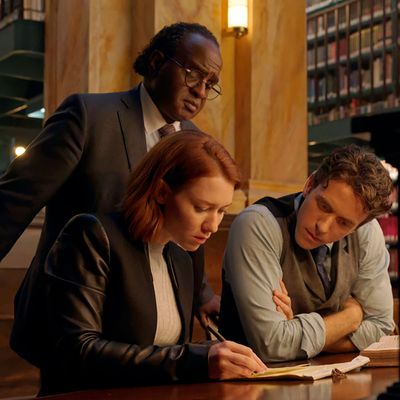
When you’re Robert Langdon, the whole world is your escape room. Over the course of the first few episodes of Peacock’s The Lost Symbol, the tweedy-yet-hunky Harvard professor runs around Washington, D.C., spouting such revelations as “It’s symbolic!” “I used a standard Masonic cipher,” and “Hang on, this sconce!” while trying to solve a grand arcane mystery involving, yes, a lost symbol. He’s a character who can resolve every problem he faces through a liberal application of basic art history, comparative religion, and maybe basic Latin, Greek, or Arabic. There are so many leaps of logic it’s basically narrative hopscotch, and some of the most fun I’ve had watching TV this fall.
If you’re aware of The Lost Symbol, it’s probably because it’s informally known as the Hot Dan Brown Show. After Tom Hanks and his misguided hair choices played Brown’s hero in the Da Vinci Code and its subsequent movies, this show casts Ashley Zukerman, a.k.a. Shiv’s sidepiece from Succession, as a younger, jockier version of the symbology professor. The show adapts one of the less mega-successful Brown novels, but follows a lot of the same conventions: There’s a conspiracist on the loose who has captured one of Langdon’s old mentors (played by Eddie Izzard), and the only way to stop him is by solving puzzles that hinge on obscure knowledge. Also, of course, there’s a love interest: Valorie Curry, as the daughter of Langdon’s mentor, who’s researching some woo-woo “Noetic science” he refuses to believe in. When she decides to help him, she hits pause on her discovery that monks chanting can stop the growth of cancer. Girl, learn to prioritize!
Once the show gets going, it carries on at a pace that’s so fast you hardly notice the number of plot holes it’s hydroplaning over. At first, Langdon works with mysterious CIA bigwig Inoue Sato (Sumalee Montano) and down-to-earth Capitol police officer Nunez (Rick Gonzalez), who has to play the whole “man of the people” foil to Sato and Langdon and, for instance, interrupt their argument about whether a code is written in Latin or Arabic to point out that they’re holding it upside down. Then, the CIA brings in Langdon for questioning because his ability to be in the right place at the right time is awfully suspicious. Of course, one of the villain’s goons immediately breaks him out and forces him to track down clues alone — now with the CIA chasing him too.
The Lost Symbol’s plot primarily serves to remind you how clever and daring Robert Langdon is, which would be annoying if the amount of self-congratulation didn’t border on the absurd. For nine out of the ten clues he runs into, he has an answer, while one of his compatriots is usually on hand for the tenth. Most of the dialogue is a grab bag of back-and-forth about random factoids that will flatter your knowledge as a viewer if you recognize them, and give you a surface-level explanation if you don’t. At one point the villain tells Langdon that his mentor Peter is “in the A’raf.” “I’m sorry, what?” Langdon responds. “The borderland between heaven and hell,” the villain says ominously. “Yes, I know what the A’raf is,” Langdon replies. Can’t catch this guy off guard.
Aside from Succession, Zukerman has already racked up a bunch of supporting TV roles, from Kate Mara’s husband in A Teacher to a physicist in the dearly (to me) departed Manhattan. He’s a bit of an expert in punchable men, but he manages, somehow, to make Langdon’s know-it-all nature charming rather than annoying. He’s more of a weirdly swole TA than a smarmy fraternity (sorry, finals club) bro, though both archetypes exist within the performance. The show has him gesture at contemporary relevance early in the season, with a lecture about symbols that turn malignant that references white supremacist coopting of things like the “don’t tread on me” snake and okay hand symbol, but doesn’t try to apply it further. Perhaps that’s a good thing, because if you pull on that strand, you realize the show’s all about congratulating a straight white guy for knowing a lot about mostly European history, which contains all the secrets of the universe.
Best, then, to stick to the surface, and what an enjoyable surface The Lost Symbol has. I chewed through the first three screeners of the show delighted by its breakneck pacing and implication that every building in Washington, D.C., contains hidden language and spatial reasoning puzzles. It’s television with little pretension to do anything more than try to keep you watching, and at that, it succeeds. I only regret that viewers who watch on Peacock will miss out on the best part of the screeners: The moment where, to indicate incomplete VFX, Peacock merely wrote in the text “a hypnotic murmuration of starlings in the sky.” It’s the most overwrought way of saying, “We don’t have the footage of the birds flying around yet,” and yet it captures The Lost Symbol’s whole vibe. Why be direct when you can use fancy words to say the same thing?





